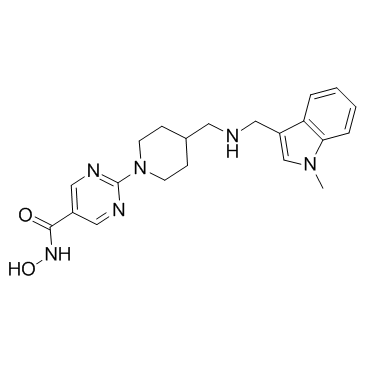Quisinostat

Quisinostat structure
|
Common Name | Quisinostat | ||
|---|---|---|---|---|
| CAS Number | 875320-29-9 | Molecular Weight | 394.47000 | |
| Density | 1.358g/cm3 | Boiling Point | 615.103ºC at 760 mmHg | |
| Molecular Formula | C21H26N6O2 | Melting Point | N/A | |
| MSDS | N/A | Flash Point | 325.803ºC | |
Use of QuisinostatQuisinostat (JNJ-26481585) is an orally available, potent HDAC inhibitor with an IC50 of 0.11 nM for HDAC1. |
| Name | N-hydroxy-2-[4-[[(1-methylindol-3-yl)methylamino]methyl]piperidin-1-yl]pyrimidine-5-carboxamide |
|---|---|
| Synonym | More Synonyms |
| Description | Quisinostat (JNJ-26481585) is an orally available, potent HDAC inhibitor with an IC50 of 0.11 nM for HDAC1. |
|---|---|
| Related Catalog | |
| Target |
HDAC1:0.11 nM (IC50) HDAC2:0.33 nM (IC50) HDAC11:0.37 nM (IC50) HDAC10:0.46 nM (IC50) HDAC5:3.69 nM (IC50) HDAC8:4.26 nM (IC50) HDAC3:4.86 nM (IC50) HDAC9:32.1 nM (IC50) HDAC6:76.8 nM (IC50) HDAC7:119 nM (IC50) |
| In Vitro | Quisinostat exerts broad-spectrum antiproliferative activity against a wide panel of cancer cell lines including lung, colon, breast, prostate, and ovarian cell lines at nanomolar concentrations. JNJ-26481585 shows activity toward all HDAC enzymes tested with highest potency in vitro observed toward recombinant HDAC1 (IC50, 0.11±0.03 nM), which is comparable with the potency observed toward HDAC1-immunoprecipitated complexes from tumor cells (IC50, 0.16±0.02 nM). Lowest in vitro potency is observed toward HDAC6, 7 and 9 (IC50, 32.1-119 nM) [1]. |
| In Vivo | JNJ-26481585 induces continuous H3 acetylation in tumor tissue in vivo. JNJ-26481585, a “second-generation” HDAC inhibitor with prolonged pharmacodynamic response in vivo. In agreement with the hypothesis, JNJ-26481585 showed superior efficacy compared with both standard of care agents and first-generation HDAC inhibitors in preclinical tumor models. These studies suggest that an HDAC inhibitor with continuous pharmacodynamic activity may show activity in solid tumor malignancies[1]. |
| Animal Admin | JNJ-26481585 is dissolved in DMSO as 5mM stock solution and diluted with appropriate medium. Human A2780 ovarian tumor cells (107 cells/mouse) are injected s.c. into the inguinal region of male athymic nu/nu CD-1 mice. When palpable tumors are obtained, mice are treated once daily with vehicle (10% hydroxypropyl-β-cyclodextrin) or JNJ-26481585 at 10 mg/kg i.p., and tumor and plasma is harvested at day 1 and at day 7 at the indicated time points (5 mice/point). Levels of AcH3 are determined using a quantitative ELISA (300 ng tumor protein/well) and described on the basis of an indirect response pharmacodynamic model[1]. |
| References |
| Density | 1.358g/cm3 |
|---|---|
| Boiling Point | 615.103ºC at 760 mmHg |
| Molecular Formula | C21H26N6O2 |
| Molecular Weight | 394.47000 |
| Flash Point | 325.803ºC |
| Exact Mass | 394.21200 |
| PSA | 95.31000 |
| LogP | 2.94030 |
| Index of Refraction | 1.688 |
| InChIKey | PAWIYAYFNXQGAP-UHFFFAOYSA-N |
| SMILES | Cn1cc(CNCC2CCN(c3ncc(C(=O)NO)cn3)CC2)c2ccccc21 |
| Storage condition | -20℃ |
| HS Code | 2933990090 |
|---|
| HS Code | 2933990090 |
|---|---|
| Summary | 2933990090. heterocyclic compounds with nitrogen hetero-atom(s) only. VAT:17.0%. Tax rebate rate:13.0%. . MFN tariff:6.5%. General tariff:20.0% |
| Quisinostat [USAN] |
| QUISINOSTAT |
| Quisinostat (USAN/INN) |
| N-Hydroxy-2-(4-((((1-methyl-1H-indol-3-yl)methyl)amino)methyl)piperidin-1-yl)pyrimidine-5-carboxamide |
| S1096_Selleck |
| UNII-9BJ85K1J8S |
| JNJ-26481585 |